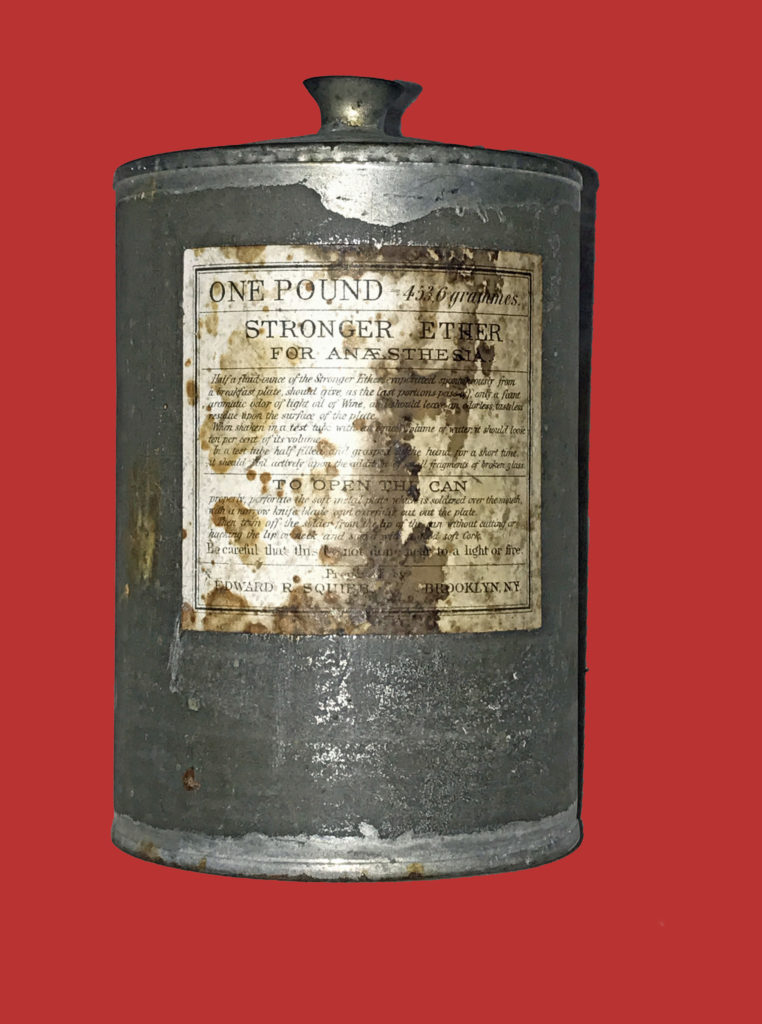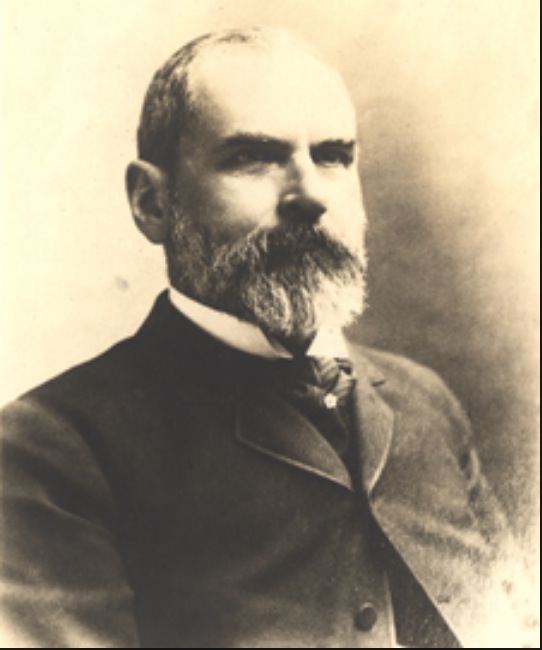RARE ORIGINAL CIVIL WAR ETHER TIN – ONE POUND SIZE
MANUFACTURED BY EDWARD R. SQUIBB OF BROOKLYN, NEW YORK c.1861
USED FOR ANESTHESIA DURING OPERATIONS

This item is a rare example of an original Civil War medical item – a one-pound sized Japanned
tin can of “stronger ether” manufactured by the famous medical purveyor, Edward R. Squibb. The tin measures 5 1/2 inches high including the spout, 5 inches along the side, and almost 3 1/2 inches across. It has the characteristic lead soldering seams so commonly seen on Civil War tin items.
It is exactly what a Civil War surgeon would have used to anesthetize a patient prior to a major operation, such as an amputation or joint excision. A cloth moistened with ether (or more commonly, chloroform) would have been held over the nose and mouth of the patient until a sufficient state of drowsiness was achieved.
EDWARD ROBINSON SQUIBB, M.D. (1814 -1900)

Edward Robinson Squibb was born in Wilmington, Delaware on July 4, 1819. In 1845, at age 26, he graduated from Jefferson Medical College in Philadelphia. He practiced medicine until he joined the U.S. Navy in 1847 as an Assistant Surgeon, serving during the ongoing Mexican-American War. Squibb became disenchanted with the poor quality of medicines used on American military vessels, which were supplied to the Navy by the lowest bidder. In 1851, he persuaded the Navy to set up a pharmaceutical laboratory at the Brooklyn Navy Yard to manufacture its most needed drugs, appointing him as the Assistant Director. There, he embarked on his life’s work to create pure pharmaceuticals. In 1854, he discovered a distillation method to create ether of a consistent strength and less volatile combustibility. This involved heating the ether by steam passing through a coil rather than by an open flame, which was dangerous. He gave away his distillation method, rather than patent it for profit. In 1857 he resigned his commission in the Navy and was subsequently persuaded by Dr. Richard Satterlee, surgeon-general of the U.S. Army, to start his own pharmaceutics manufacturing business to supply the U.S. Army with reliable drugs. In September 1858, he opened his factory on Furman Street in Brooklyn, New York.
On Christmas Eve, 1858, a young assistant caused a volatile ether fire in the Squibb laboratory. Attempting to save his journals, E.R. caught fire himself. Fighting for life for weeks, he slowly recovered, but his face was badly scarred and his eyelids were permanently turned back. Though he didn’t lose his sight, for the remainder of his life he had to wear special protective glasses and tape his eyelids shut in order to sleep. Shortly thereafter, one of his hands had to be amputated, ‘according to his own specification’. Despite these disabilities, the determined Dr. Squibb borrowed the financing to rebuild his laboratory by the end of 1859.
With his focus on the production of superior pharmaceuticals, his business flourished and by the onset of the Civil War in 1861, his pharmaceutical and chemical factory was producing products around-the-clock. E.R. Squibb became the source of medicines for the Union Army during the Civil War. He invented the Squibb pannier—a compact, metal-bound wooden medicine chest used on the battlefield—filled with 52 standard medicines packaged in Japanned tin containers (as shown here) to treat casualties. The chest sold for about $100, and included ether and chloroform for use as an anesthetic during amputations, quinine and whiskey to treat symptoms of malaria, and herbal treatments for dysentery and other diseases that ravaged the unsanitary military camps.
In 1892 Squibb created a partnership with his two sons, Dr. Edward H. Squibb and Charles F. Squibb, the firm being known for generations afterwards as E. R. Squibb and Sons. E.R. retired from the firm in 1895, and passed most of the responsibility for managing the firm to his sons.
E.R. Squibb published all of his discoveries and findings, but never applied for patents for any of his formulas. It was his philosophy that scientific breakthroughs and discoveries should be available for public benefit.
Squibb died on October 25, 1900, at his home in Brooklyn, New York, from a ruptured blood vessel.
THE USE OF ANESTHESIA DURING THE CIVIL WAR

Let’s begin by dispelling the Hollywood myth right off the bat. Despite the typical movie portrayal of a wounded soldier biting on a stick and being held down by others while his leg is being amputated, the truth is:
Anesthesia was used in 95% of Civil War surgeries!
Having gotten that out of the way, now for some history. Although ether was discovered in 1275 by a Spanish chemist, it wasn’t until 1841 that the anesthetic property of ether was put to work. After witnessing “ether frolics”, public gatherings of those who would take ether for amusement, and noting the lack of pain felt by those getting injured at these events, Dr. Crawford H. Long returned from schooling in Pennsylvania to his hometown of Jefferson, Georgia. While it is believed Dr. Long used ether for minor operations in 1841, the first recorded use of ether as an anesthetic occurred on March 30, 1842, when Long used applied it in the removal of two tumors from the neck of James M. Venable. Venable felt no pain from the procedure and paid two dollars for the tumor extraction. Four years later, on September 30, 1836, Dr. William Morton, a former dental partner of Dr. Horace Wells, who had advocated the use of nitrous oxide as an anesthetic, administered ether to remove a tooth of a patient in Boston. In October of the same year, Morton gave a public demonstration of ether’s anesthetic property at Massachusetts General Hospital. With the procedure occurring with great success, Morton was later wrongly credited as the discoverer of ether’s surgical use. The year following the successful demonstration, Sir James Young Simpson, a future pioneer in anesthesiology, introduced ether for use as an anesthetic for childbirth.
By the time the Civil War broke out in 1861, both ether and chloroform had been in use for years as methods of surgical anesthesia (chloroform was discovered in 1832). Although both were indispensable, chloroform soon emerged as the more widely used, as it took action faster and was non-flammable. This was particularly important to surgeons operating at night under an open flame. Chloroform was administered by placing the anesthetic on a sponge at the top of a cone, then covering the patient’s nose and mouth with the open end. It took an average of 9 minutes to take effect. Although ether was administered in a similar manner, with a folded towel or sponge soaked with ether placed over the nose and mouth, it was once again, more problematic than chloroform. It required a larger quantity of the liquid, and twice as long to take effect.
The standard method of soaking a cloth with anesthetic was popular but wasteful, because the liquid evaporated so quickly. This was a particular problem for Confederate surgeons, whose access to anesthetics was severely restricted by the Northern Blockade. A Southern doctor named Julian John Chisholm solved the dilemma by inventing a 2.5-inch inhaler, the first of its type. Chloroform was dripped through a perforated circle on the side onto a sponge in the interior; as the patient inhaled through tubes, the vapors mixed with air. This new method required only one-eighth of an ounce of chloroform, compared to the old 2-ounce dose, and enabled Confederate surgeons to treat nearly as many surgical cases as Union surgeons, with a fraction of the supplies.
JULIAN JOHN CHISHOLM, M.D.

THE CHISHOLM INHALER

